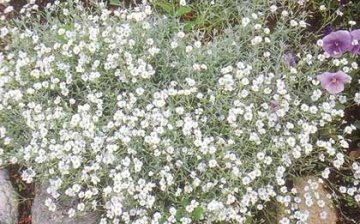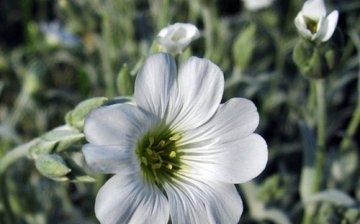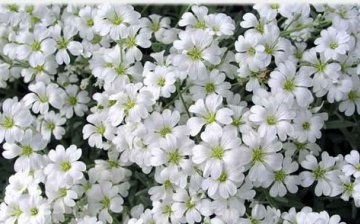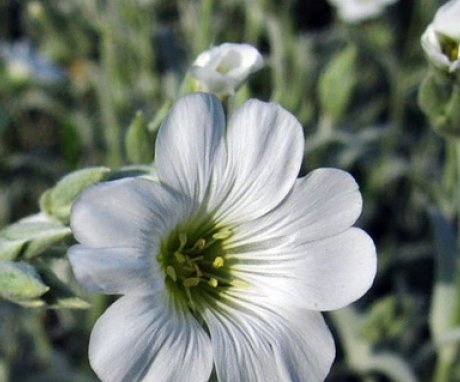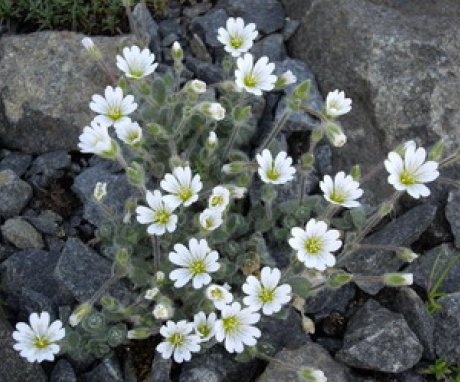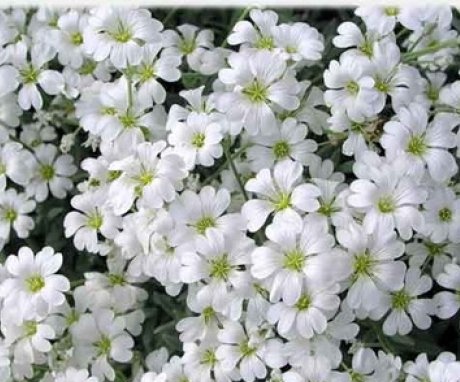Growing chickens and caring for it
Yaskolka is a herbaceous creeping ground cover plant and has about 100 species. Yaskolka is valued not only for its flowers, the plant is also decorative and deciduous, its silvery foliage can be enjoyed until late autumn. Flowering begins in May and lasts a month and a half. At the end of flowering, fruit boxes with seeds appear.
Content:
Planting and breeding chickens
Growing chickweed does not present any difficulties, the plant is very unpretentious. It is suitable for planting even in rocky gardens and in the lowest areas of alpine slides. The most common types of chive are:
- Bieberstein's louse (Cerastium biebersteinii). The most common creeping species. The shoots form a dense carpet. During flowering, they rise up to 20 cm above the soil. Leaves are oblong, silvery-pubescent. The flowers are white, up to 1.5 cm in diameter, collected in inflorescences. Blooms in May, and seed boxes ripen in July;
- Alpine (Cerastium alpinum). Creeping stems, oval-shaped leaves. The plant is covered with white-silvery hairs. The flowers are snow-white, up to 2 cm in diameter, collected in inflorescences of 4-5 flowers. Flowering period - late May and early June;
- Felt (Cerastium tomentosum). Stems up to 30 cm high, creeping, branched, ascending. Felt leaves, grayish color. Flowers up to 2 cm in diameter, white, collected in loose brushes. Blooms in May - June.
Drained loose, sandy loam are suitable for planting chicks. soil... The place should be sunny. For normal growth, development and flowering, one plant is allocated a place with a diameter of up to 30 cm. Before planting, prepare the soil: loosen it, and if the soil is clay, then add ordinary sand. There is no need to fertilize the soil for planting the chippers.
Propagated by dividing the bush, cuttings and seeds.
The division of the bushes is carried out in spring or autumn. In order to facilitate the division and planting of bushes, they are trimmed. It is advisable to perform the procedure every 4 years, otherwise the jascola loses its decorative effect.
Root cuttings in a garden bed in partial shade or in a greenhouse. Cuttings cut after flowering take root well. Spring cuttings are less effective because after wintering the plant does not have sufficient strength for rooting.
The best way to reproduce a chick is by growing seedlings from seeds. Seeds are sown in pots with drained soil in late April - early May and watered 2-3 times a week. At a temperature of 21-23 degrees, the first shoots appear in two weeks. If the seedlings are weak, they must be planted in picking cups or in a box. After the seedlings get stronger, they can be planted in open ground.
Chip care
Caring for the shingle requires regular watering, but not often, about once a week, so that the soil does not dry out. Being in excessive humidity for a long time, the chickweed is attacked by a fungus.
Two or three times during the growing season, the plant can be fed mineral fertilizers... In 10 liters of water dissolve 2 tablespoons of fertilizer "Flower" or its analogs, made on the basis of peat with the addition of micro- and macroelements. The solution is insisted throughout the day.
For the winter, the yaskolka is covered with spruce branches or at least dry leaves, if there is little snow, it can freeze out.The chrysalis grows strongly and can drown out neighboring plants, so the lateral shoots need to be pruned periodically. After pruning, the chrysalis may bloom again.
Chimney in garden design
In garden design, the chimney is a real find. It is not only great during flowering. Its silvery-pubescent greens are effectively combined with plants that have a dark green color.
Yaskolka is an excellent material for arranging various borders, both independently and in combination with other ground cover. The border looks very nice, where subulate phlox with pink flowers is planted in the foreground, and the chickweed is planted on the second. They bloom at the same time, and it is difficult to find a more graceful ground cover border at this time of the season. When this splendor fades, the curb remains attractive thanks to the combination of emerald green phlox and a silvery chuck.
Another original solution could be planting the chicks in the foreground in the mixboard, where the red ones are located in the background. tulips, and on the third - blue irises.
The shingle looks original on the alpine hills among the stones. Planted at the foot, it creates a smooth transition from a slide to a flat garden surface. This design technique contributes to the naturalness of the entire composition.
Chicks are planted not only in open ground, but also in pots or containers. When it blooms, it is placed next to bright flowering plants to create color contrasts.



